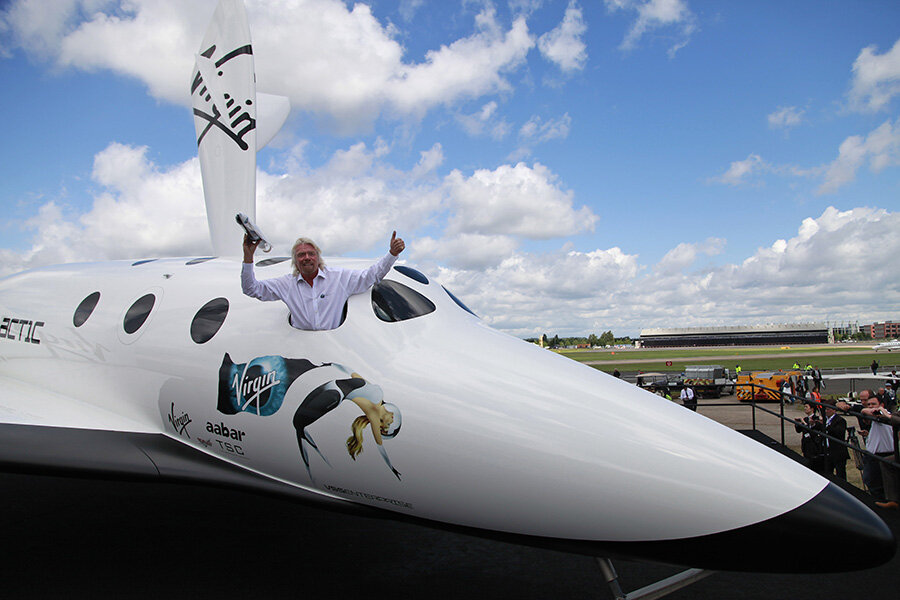Uncertainty looms over Houston's future as a 'Space City'
With two corporations, SpaceX and Orbital Sciences, already delivering supplies to NASA's International Space Station, a golden age may be at hand for private space firms.
Late this year, Virgin Galactic may launch its first suborbital flight, opening space to non-astronauts. And private companies are beginning to announce dates by which they'll be ready to fly astronauts into orbit, a venture that until now has been solely the province of governments.
"We're seeing a democratization of access to space," said Michael Lopez-Alegria, a four-time astronaut who now leads the industry group Commercial Spaceflight Federation, told the Houston Chronicle (http://bit.ly/1dpwBTb).
The rise of commercial space raises questions about the future of Houston as Space City, which for the entire history of U.S. spaceflight has been responsible for training and managing the flights of U.S. astronauts. Houston is racing to reinvent itself this decade as other parts of the country seek to chip away at its pre-eminence as the home of human spaceflight.
For now, Johnson Space Center will continue to be the home of NASA astronauts, but it's not clear what role the center will have in working with astronauts who fly on privately-built commercial vehicles to space.
NASA, for example, chose to establish its office overseeing the development of private spacecraft that will eventually carry U.S. astronauts to the space station at Kennedy Space Center in Florida, instead of at the Houston-based center.
The Houston region has not been oblivious to the rise of commercial space and its implications for the city's traditional hegemony in human spaceflight.
"Houston is being very proactive," said David Alexander, director of the Rice Space Institute.
Texas A&M recently held a commercial space workshop with Rice and industry partners to discuss a commercial space strategy for Houston and Texas. Universities, governments and industry partners will need to work together to ensure the vibrancy of Houston's space presence, Alexander said.
The centerpiece of the region's efforts is the development of a spaceport.
Last September, the Houston Airport System unveiled preliminary plans to develop a 450-acre spaceport at Ellington Airport. Houston aviation director Mario Diaz said he envisions a facility that would be home to space tourism as well as support aerospace hangars, manufacturing facilities, educational institutions and museums.
According to Darian Ward, a spokeswoman for the airport system, the city is about halfway through completing its application for an FAA license to operate the spaceport. The airport system expects to submit the license this summer and if all goes well could receive approval by the end of the year.
"The process is on time, and I believe that is significant," Ward said.
Houston would be entering a competitive market. There are already more than a dozen government and private spaceports, with widely varying amounts of activity, in operation in the United States.
With a number of financial incentives, Spaceport America, in New Mexico, has secured a deal with Virgin Galactic to launch flights of SpaceShipTwo from there.
Despite a number of delays, the company's founder, Richard Branson, has said commercial flights from the spaceport should begin as soon as the end of this year. The company has already pre-sold more than 600 tickets at a cost of $200,000 each for flights to about 60 miles above the Earth, providing a spectacular view and a few minutes of weightlessness.
Celebrities such as Brad Pitt, Angelina Jolie and Leonardo DiCaprio have signed up, ensuring that commercial space will make a splash on the public consciousness when Virgin Galactic begins flying.
"Imagine doubling the number of people who have been in space in 50 years in a couple of years," said Lopez-Alegria, the commercial spaceflight official. "That's great, and I think that that will energize people."
Perhaps most importantly, however, Lopez-Alegria noted that some companies already flying into space are helping to shift the perception of commercial space in Congress.
When he used to visit politicians to discuss commercial space, Lopez-Alegria said, there were a lot of skeptics. Then SpaceX and Orbital Sciences began flying successful missions on their own rockets to the space station, bringing up supplies on a regular basis.
"There are a lot fewer skeptics out there," he said. "You can't argue with success. I think that those two companies doing what they have done has been fundamental to what has been a sea change in the perception of commercial space."
That, in turn, has opened the congressional purse strings a bit.
NASA has been working with SpaceX, Boeing and Sierra Nevada Corporation to develop private spacecraft that could fly astronauts to orbit and allow NASA to stop paying the Russians hundreds of millions of dollars annually to do so.
During the 2012, 2013 and 2014 budget cycles, President Barack Obama has requested about $800 million annually or a little more to stimulate this development. In 2012 and 2013, Congress only obliged with about $500 million, slowing the efforts of these companies to deliver ready-to-fly spacecraft.
In 2014 Congress went higher, funding $700 million of the commercial crew request.
"I'd call it a win," Lopez-Alegria said. "I think people are pretty happy with it, and that just sort of speaks to what expectations are because of what's happened during the last couple of years."
Around the same time as the budget deal, Sierra Nevada Corp., based in Nevada, announced that it would conduct the first flight of its mini space shuttle-like Dream Chaser in 2016. It's racing with SpaceX and Boeing for NASA funds and the delivery of human-ready spacecraft.
"SNC is thrilled to be the first company to confirm a launch date for our country's return to orbital human spaceflight," Mark Sirangelo, the head of the company's space segment, said at the late-January announcement.
It will launch from Florida. However, what role Johnson Space Center will play in the flight, if any, is unclear.






